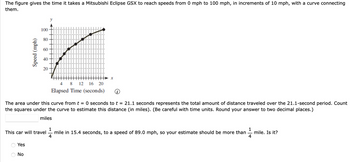
Calculus: Early Transcendentals
8th Edition
ISBN: 9781285741550
Author: James Stewart
Publisher: Cengage Learning
expand_more
expand_more
format_list_bulleted
Question

Transcribed Image Text:The figure gives the time it takes a Mitsubishi Eclipse GSX to reach speeds from 0 mph to 100 mph, in increments of 10 mph, with a curve connecting
them.
оо
Speed (mph)
Yes
100
No
80
60
40
This car will travel
20
The area under this curve from t = 0 seconds to t = 21.1 seconds represents the total amount of distance traveled over the 21.1-second period. Count
the squares under the curve to estimate this distance (in miles). (Be careful with time units. Round your answer to two decimal places.)
miles
4
8 12 16 20
Elapsed Time (seconds)
X
1
4
1
mile in 15.4 seconds, to a speed of 89.0 mph, so your estimate should be more than mile. Is it?
4
Expert Solution
This question has been solved!
Explore an expertly crafted, step-by-step solution for a thorough understanding of key concepts.
This is a popular solution
Trending nowThis is a popular solution!
Step by stepSolved in 3 steps with 1 images

Knowledge Booster
Similar questions
- A new car worth $22,000 is depreciating in value by $2000 per year. Complete parts (a) through (c) a. Write a formula that models the car's value, y, in dollars, after x years. b. Use the formula from part (a) to determine after how many years the car's value will be $16,000. c. Graph the formula from part (a) in the first quadrant of a rectangular coordinate system Then, show your solution to part (b) on the graph. a. A formula that models the car's value, y, in dollars, after x years is (Type an equation.) b. After years, the car's value will be $16,000. (Type a whole number.) c. Choose the correct graph below. OA. OB. Oc. OD. Ay 22,000 Ay 10+ 10- 22,000- 0+ 10 2200 2200 Click to select your answer(s). P Type here to search A 4) C PrtSc Insert Delete F3 F4 F5 F6 F7 F8 F9 F10 F11 F12 F1 F2 @ & Backspacearrow_forwardPis a parallelogram. What additional informatio rectangle? 5. M(2.4) The length of LM is - The slope of LP and M 4. 1) 2 N(3,2) LM II PN LP 1 PN 5 -4 3 3 4 P(-3,-1) 2 -5arrow_forwardWrite a report summarizing your findings. When writing the report consider that medical staff estimate that a difference of 4.5 microns or more could impact on their ability to interpret eye pressure correctly.arrow_forward
- QUESTION B9 Find the length and width of a rectangle, with perimeter p, so that it's has a maximum area. Find the maximum area. A. length =p; width=÷p B. length =-p, width = %3D %3D c. length = p; width=p D. length =p, width = p %3D %3Darrow_forwarda and b pleasearrow_forwardThe table shows the number of adult softball teams since 1990, where x represents the year since 2000 and y represents the number of teams (in thousands). Make a scatter plot of the data and determine which type of model best fits the data. Year, x 0 1 2 3 4 Number of teams (in thousands) 163 155 149 143 119 linear quadratic exponential cubicarrow_forward
arrow_back_ios
arrow_forward_ios
Recommended textbooks for you
 Calculus: Early TranscendentalsCalculusISBN:9781285741550Author:James StewartPublisher:Cengage Learning
Calculus: Early TranscendentalsCalculusISBN:9781285741550Author:James StewartPublisher:Cengage Learning Thomas' Calculus (14th Edition)CalculusISBN:9780134438986Author:Joel R. Hass, Christopher E. Heil, Maurice D. WeirPublisher:PEARSON
Thomas' Calculus (14th Edition)CalculusISBN:9780134438986Author:Joel R. Hass, Christopher E. Heil, Maurice D. WeirPublisher:PEARSON Calculus: Early Transcendentals (3rd Edition)CalculusISBN:9780134763644Author:William L. Briggs, Lyle Cochran, Bernard Gillett, Eric SchulzPublisher:PEARSON
Calculus: Early Transcendentals (3rd Edition)CalculusISBN:9780134763644Author:William L. Briggs, Lyle Cochran, Bernard Gillett, Eric SchulzPublisher:PEARSON Calculus: Early TranscendentalsCalculusISBN:9781319050740Author:Jon Rogawski, Colin Adams, Robert FranzosaPublisher:W. H. Freeman
Calculus: Early TranscendentalsCalculusISBN:9781319050740Author:Jon Rogawski, Colin Adams, Robert FranzosaPublisher:W. H. Freeman
 Calculus: Early Transcendental FunctionsCalculusISBN:9781337552516Author:Ron Larson, Bruce H. EdwardsPublisher:Cengage Learning
Calculus: Early Transcendental FunctionsCalculusISBN:9781337552516Author:Ron Larson, Bruce H. EdwardsPublisher:Cengage Learning

Calculus: Early Transcendentals
Calculus
ISBN:9781285741550
Author:James Stewart
Publisher:Cengage Learning

Thomas' Calculus (14th Edition)
Calculus
ISBN:9780134438986
Author:Joel R. Hass, Christopher E. Heil, Maurice D. Weir
Publisher:PEARSON

Calculus: Early Transcendentals (3rd Edition)
Calculus
ISBN:9780134763644
Author:William L. Briggs, Lyle Cochran, Bernard Gillett, Eric Schulz
Publisher:PEARSON

Calculus: Early Transcendentals
Calculus
ISBN:9781319050740
Author:Jon Rogawski, Colin Adams, Robert Franzosa
Publisher:W. H. Freeman


Calculus: Early Transcendental Functions
Calculus
ISBN:9781337552516
Author:Ron Larson, Bruce H. Edwards
Publisher:Cengage Learning